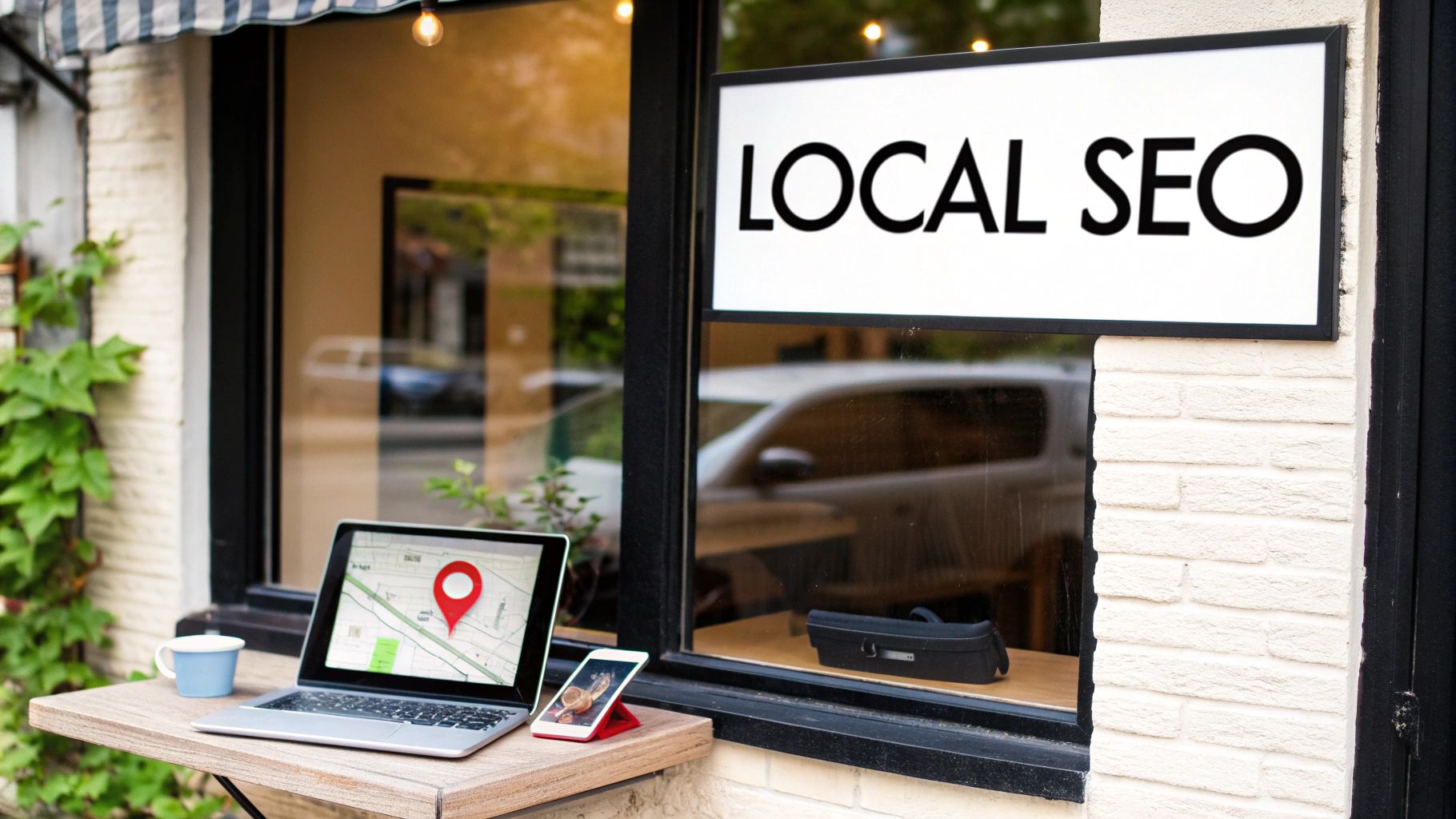Tired of marketing that doesn’t work? Let’s fix that.
Running a local shop in Menifee or Murrieta, an e-commerce store in Southern California, or a service-based business that relies on steady lead flow can feel like juggling flaming torches. You need marketing that turns your website into a 24/7 salesperson and delivers predictable revenue. No more guesswork or wasted ad spend—just clear, repeatable digital marketing tips for small business owners who demand ROI.
This guide skips generic advice and jargon. We’ve outlined ten strategies for companies doing $500K–$2M annually. Each tip focuses on practical steps you can start today—whether you need better local SEO, smarter PPC, or an email funnel that actually converts.
In this roundup you’ll find:
- Search Engine Optimization (SEO) for Local Business
- Content Marketing and Blogging
- Social Media Marketing and Engagement
- Email Marketing and Newsletter Campaigns
- Pay-Per-Click (PPC) Advertising
- Video Marketing and YouTube Strategy
- Influencer Marketing and Partnerships
- Conversion Rate Optimization (CRO) and Analytics
- CRM and Marketing Automation
- Community Building and Brand Loyalty Programs
Each section delivers:
- Actionable steps you can implement this week
- Real examples from local auto shops, dental offices, contractors, and e-tailers
- Quick wins to improve results fast
- Strategic advice on measuring and scaling success
We’re Uncommon Web Design—your strategic growth partner. Ready to stop wasting time and budget? Scroll down and let’s get started.
1. Search Engine Optimization (SEO) for Local Business
Local SEO makes your business visible to customers searching nearby. When someone in Murrieta types “plumber near me,” you want to appear in the map pack or top organic results, not lose that lead to a competitor down the street.

How to implement local SEO
- Optimize your Google Business Profile: Fill out every section—services, hours, photos, description, service areas.
- Encourage and respond to reviews: Ask satisfied customers to leave feedback. Reply professionally to all reviews.
- Build consistent local citations: List your Name, Address, Phone (NAP) on Yelp, BBB, industry directories with identical details.
- Create location-specific pages: Serve multiple areas? Make dedicated pages for Menifee, Temecula, etc., mentioning landmarks and keywords like “HVAC repair in Menifee, CA.”
Learn more about SEO for service-based businesses on uncommonwebdesign.com.
2. Content Marketing and Blogging
Content marketing is about answering customer questions before they ask them. A blog post on “Signs Your AC Unit Needs Repair” positions a Menifee HVAC company as an expert and feeds your SEO and social channels.

How to implement content marketing
- Answer top customer questions: List your ten most common queries—each becomes a blog post.
- Publish consistently: One or two high-quality posts per month signals activity to search engines.
- Optimize every post: Target a keyword, add a clear call-to-action (e.g., “Schedule a Free Estimate”), and link to service pages.
- Repurpose content: Turn a popular post into an Instagram video, an email checklist, or a Pinterest infographic.
Get more tips on mastering your business blog posts on uncommonwebdesign.com.
3. Social Media Marketing and Engagement
Social media for small business is about community, not going viral. Use Facebook, Instagram, or LinkedIn to humanize your brand, showcase real work, and stay top of mind.

How to implement social media marketing
- Pick the right platforms: Contractors shine on Instagram; B2B consultants excel on LinkedIn.
- Plan with a simple calendar: Mix promotions, behind-the-scenes, testimonials, and helpful tips.
- Respond quickly and genuinely: Reply to comments and DMs—social media is a conversation.
- Use native features: Try Instagram Reels for project demos or Facebook Events for local workshops.
4. Email Marketing and Newsletter Campaigns
Email marketing gives you a direct line to customers—no algorithm between you and their inbox. It’s a top ROI channel when you nurture leads and drive repeat sales.
How to implement email marketing
- Build your list organically: Offer a first-purchase discount or free guide. Place sign-up forms on your site and at checkout.
- Create a welcome sequence: Send 2–3 automated emails introducing your story and delivering the incentive.
- Segment your audience: Group subscribers by purchase history or interests for targeted messages.
- Provide value first: Follow an 80/20 rule—80% educational content, 20% promotions.
Learn how to integrate Mailchimp and WordPress by mastering Mailchimp and WordPress integration on uncommonwebdesign.com.
5. Pay-Per-Click (PPC) Advertising
PPC puts you at the top of search results immediately. It’s ideal for new services, time-sensitive offers, or filling gaps while your SEO ramps up.
How to implement PPC
- Start small, target high-intent keywords: Test with a modest budget on terms like “emergency plumber Menifee.”
- Craft benefit-driven ad copy: Use a clear headline, concise description, and strong CTA (“Get a Free Quote Today”).
- Send traffic to dedicated landing pages: Match the ad promise with a page designed for one action—conversion.
- Enable conversion tracking: Measure which keywords and ads generate calls, leads, or sales.
- Use ad extensions: Add your phone number, location, sitelinks, and key callouts to boost click rates.
6. Video Marketing and YouTube Strategy
Video lets you show your work, not just describe it. YouTube is the second-largest search engine—customers watch tutorials before they buy.
How to implement a video strategy
- Start with your smartphone: Authentic, behind-the-scenes clips often connect better than polished ads.
- Create quick how-tos: An HVAC company could demo “How to Change Your Air Filter.”
- Optimize titles and descriptions: Use keywords so people find you on YouTube and Google.
- Repurpose clips: Turn a 10-minute video into 60-second social posts or podcast snippets.
- Embed videos everywhere: Add them to blog articles, service pages, and emails for higher engagement.
7. Influencer Marketing and Partnerships
Influencer marketing for small biz means working with niche micro-influencers (10K–100K followers) who have real engagement. A Murrieta food blogger can give your cafe a trusted thumbs-up to an eager local audience.
How to implement influencer marketing
- Choose micro-influencers: They deliver higher engagement and feel like a friend’s recommendation.
- Vet beyond followers: Look at comments and interactions—aim for 3%+ engagement.
- Build rapport first: Follow, comment, and genuinely connect before pitching.
- Offer performance-based deals: Use affiliate codes or trackable links so you pay for actual sales.
- Give creative freedom: Provide guidelines but let them present your brand in their voice.
8. Conversion Rate Optimization (CRO) and Analytics
Getting traffic is only half the battle. CRO uses data to turn more visitors into customers—boosting revenue from the marketing you already pay for.
How to implement CRO and analytics
- Install analytics & heatmaps: Use Google Analytics for goals and Hotjar to see where users click and drop off.
- Remove friction: Simplify lengthy forms, speed up pages, and clarify your calls-to-action.
- Run A/B tests: Test headlines, button colors, or layouts on key pages and compare performance.
- Define clear goals: Track form fills, calls, or purchases in Analytics to measure ROI by channel.
9. Customer Relationship Management (CRM) and Marketing Automation
A CRM organizes customer data, tracks every interaction, and ensures no lead slips through. Add automation and you have a 24/7 follow-up engine.
How to implement CRM & automation
- Pick a scalable tool: Start with HubSpot or Pipedrive—free plans cover small-business needs.
- Import and segment your data: Tag contacts as new leads, active clients, or past customers.
- Automate follow-ups: Set up a workflow that sends nurturing emails when someone fills out your contact form.
- Integrate key tools: Link your CRM to email, calendar, and web forms for seamless data flow.
10. Community Building and Brand Loyalty Programs
Community building transforms customers into advocates. A loyal tribe not only buys from you but also spreads the word.
How to implement community & loyalty
- Launch an exclusive group: A private Facebook Group or Circle channel gives VIP access to your best customers.
- Offer tiered rewards: Points or Bronze/Silver/Gold tiers unlock perks like free shipping or exclusive products.
- Spotlight advocates: Share customer stories, repost UGC, or send surprise gifts.
- Host member-only events: Online challenges, local meetups, or Q&A sessions deepen engagement.
Ready to turn these digital marketing tips for small business into a predictable growth engine? At Uncommon Web Design, we specialize in integrating SEO, content, social, and paid channels into one powerful system. Schedule a no-obligation consultation today, and let’s map out a clear plan to get you the results you deserve.



